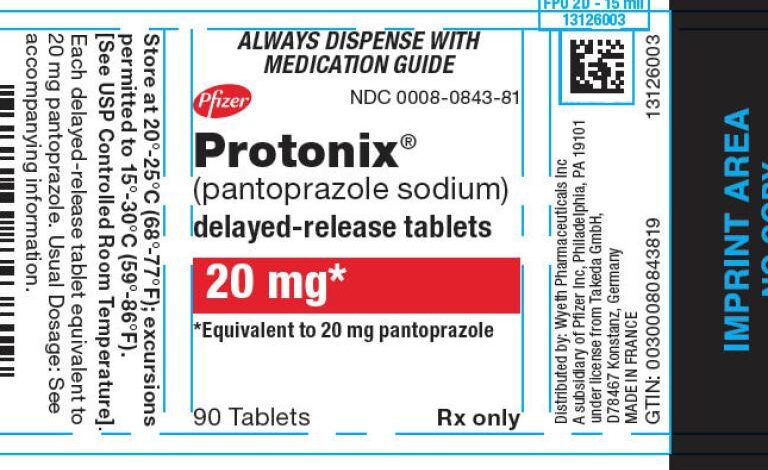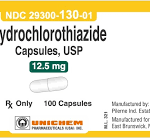What Are The Most Common Side Effects of Pantoprazole?

Pantoprazole, sold under the brand name Protonix among others, is a medication used to treat certain stomach and esophagus problems (such as acid reflux). It works by decreasing the amount of acid your stomach makes. This medication relieves symptoms such as heartburn, difficulty swallowing, and persistent cough.
Pantoprazole was discovered by scientists at Byk Gulden, a subsidiary of Altana in 1985. The compound from which Pantoprazole was created was actually synthesized by chemists working on scaleup of a different chemical that had been chosen as a development candidate.
How pantoprazole works
Pantoprazole is a type of medicine called a proton pump inhibitor (PPI). Proton pumps are tiny substances in the lining of the stomach that help it make acid to digest your food. Pantoprazole prevents proton pumps from working properly. This reduces the amount of acid the stomach makes. After you take pantoprazole you should start to feel better within 2 to 3 days. It may take up to 4 weeks for pantoprazole to work properly so you may still have some symptoms during this time.
How should pantoprazole be used?
Pantoprazole comes as a delayed-release (releases the medication in the intestine to prevent break-down of the medication by stomach acids) tablet and as delayed-release granules to take by mouth. The packets of delayed-release granules must be mixed with applesauce or apple juice and taken by mouth or given through a feeding tube. For the treatment and maintenance of GERD, pantoprazole is usually taken once a day. For the treatment of conditions where the stomach produces too much acid, pantoprazole is usually taken twice a day. The delayed-release tablets are usually taken with or without food, and the granules are usually taken 30 minutes before a meal. Take pantoprazole at around the same time(s) every day. Follow the directions on your prescription label carefully, and ask your doctor or pharmacist to explain any part you do not understand. Take pantoprazole exactly as directed. Do not take more or less of it or take it more often or for a longer period of time than prescribed by your doctor.
Swallow the tablets whole; do not split, chew, or crush them. If your doctor has prescribed the 40 mg tablet and it is too big for you to swallow, ask your doctor to prescribe two of the 20 mg tablets instead.
To take the granules, open the packet and either sprinkle the granules onto one teaspoonful of applesauce or into a cup containing one teaspoonful of apple juice. Do not mix the granules with water, other liquids, or other foods. Use all of the granules in the packet; do not divide the granules into smaller doses. If you sprinkle the granules into apple juice, stir the mixture for 5 seconds. Swallow the mixture of applesauce or apple juice and medication right away (within 10 minutes) without chewing or crushing the granules. If you sprinkled the granules on applesauce, take several sips of water to wash the granules down to your stomach. If you sprinkled the granules into apple juice, rinse the cup once or twice with apple juice and drink the apple juice right away to be sure you swallow any leftover granules.
Pantoprazole granules mixed with apple juice may be given through a feeding tube. If you have a feeding tube, ask your doctor how you should take pantoprazole.
Continue to take pantoprazole even if you feel well. Do not stop taking pantoprazole without talking to your doctor. If your condition does not improve or gets worse, call your doctor.
Ask your pharmacist or doctor for a copy of the manufacturer’s information for the patient.
What are the most common side effects of pantoprazole?
The most common side effects of pantoprazole include:
- headache.
- diarrhea.
- stomach pain.
- nausea or vomiting.
- gas.
- dizziness.
- joint pain.
The general list of pantoprazole side effects include:
- headache
- nausea
- vomiting
- gas
- joint pain
- diarrhea
- dizziness
Some side effects may be serious. If you experience any of the following symptoms, call your doctor immediately, or get emergency medical help
- blistering or peeling skin
- rash hives; itching; swelling of the eyes, face, lips, mouth, throat, or tongue; difficulty breathing or swallowing; or hoarseness
- irregular, fast, or pounding heartbeat muscle spasms; uncontrollable shaking of a part of the body; excessive tiredness; lightheadedness; or seizures
- severe diarrhea with watery stools, stomach pain, or fever that does not go away
- rash on cheeks or arms that is sensitive to sunlight
- increased or decreased urination, blood in urine, fatigue, nausea, loss of appetite, fever, rash, or joint pain
Pantoprazole may cause other side effects. Call your doctor if you have any unusual problems while taking this medication.
People who take proton pump inhibitors such as pantoprazole may be more likely to fracture their wrists, hips, or spine than people who do not take one of these medications. People who take proton pump inhibitors may also develop fundic gland polyps (a type of growth on the stomach lining). These risks are highest in people who take high doses of one of these medications or take them for one year or longer. Talk to your doctor about the risks of taking pantoprazole.
Pantoprazole Safety Information
Doctors should follow up with people taking pantoprazole. After completing the treatment, if a person still has symptoms, the doctors should investigate whether or not the diagnosis was indeed accurate.
Sometimes, people may feel much better after the treatment is complete, but their symptoms may quickly return. Doctors may perform further tests, including an endoscopy.
An endoscopy involves passing a flexible tube with a camera attached, called an endoscope, into the stomach through the mouth to see the inside of the body.
Kidney conditions
Taking pantoprazole can lead to a kidney condition called acute interstitial nephritis. This may occur in people with a sensitivity to PPIs.
If a doctor detects this condition, they will stop the medication immediately.
Bacterial infections
According to the Food and Drug Administration (FDA), pantoprazole is a category c drug, this means that animal studies suggest that the drug could harm a fetus. However, researchers have not studied how safe the drug is for pregnant women. In some cases, the potential benefits might allow for the use of pantoprazole during pregnancy. Pantoprazole is released into human breast milk, but the effects on the infant remains unclear. If a person is breastfeeding and considering taking pantoprazole, they should speak with their doctor to evaluate the risks versus benefits to the nursing child.
Several studies have linked the use of pantoprazole with C. difficile diarrhea. This infective diarrhea can be fatal, particularly among older adults. Doctors should prescribe the lowest effective dosage for the shortest time possible to prevent this infection.
Bone problems
People taking high doses, multiple times per day, and for extended periods are also at risk of fractures of the hip, wrist, or spine.
Skin problems
A severe skin condition called cutaneous lupus erythematosus has occurred in some people taking pantoprazole. This condition may develop after a few weeks to a few years of continuous use of this drug. Once the person stops taking the drug, symptoms will improve in about 4–12 weeks.





